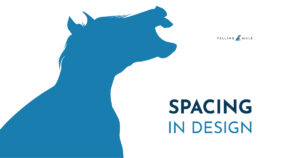
In design, space is defined as the distance around the area between different design elements. Basically, if you put an element on a composition, space refers to the area that does not include the element. Space delivers a message just as much – if not more – than other elements within a design. It lets your design breathe and can convey importance and emphasis throughout. Using it strategically can make or break a design.
Spacing creates visual relationships and connections between elements. In design, we hear the term “design flow” frequently. This is the way a design is composed for a viewer’s eyes to move about a composition. The use of space can help guide this flow and aid an audience in interpreting the concept. Poor spacing in design can visually disengage a viewer. It can make them not understand the intended message, and leave them feeling confused. Bad spacing makes a composition both unbalanced and unattractive.
Below are important terms to keep in mind when designing your next composition.
Positive Space
Positive space is the subject element within the design. Essentially, you want this to be the area of interest for a viewer. Positive space is the element of the design in which people typically pay more attention to.
Negative Space
Negative space is often the background to a positive space. It delegates importance throughout a composition and can support the positive space in gaining attention. Negative space does not have to be blank. Negative space should receive equal attention to ensure that viewers can understand the environment and purpose of the positive space.
Keeping track of both positive and negative space can help keep design more balanced. Beginners to design often feel pressure to fill a composition, but doing so can create a chaotic visual. Prioritizing both positive and negative space is what keeps your design breathable.

